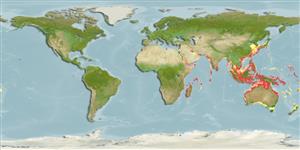Common names from other countries
>
Syngnathiformes (Pipefishes and seahorses) >
Centriscidae (Snipefishes and shrimpfishes) > Centriscinae
Etymology: Centriscus: Derived from Greek, kentris, -idos = sting (Ref. 45335).
More on author: Linnaeus.
Environment: milieu / climate zone / depth range / distribution range
Ecología
marino; salobre asociado a arrecife; rango de profundidad 2 - 100 m (Ref. 37816), usually 2 - 15 m (Ref. 90102). Tropical; 34°N - 35°S, 32°E - 172°E
Indo-Pacific: Red Sea and Arabian Gulf (Ref. 11441) to New Guinea, north to southern Japan, south to New South Wales, Australia.
Tamaño / Peso / Age
Maturity: Lm ? range ? - ? cm
Max length : 17.0 cm TL macho / no sexado; (Ref. 110387)
Espinas dorsales (total) : 3; Radios blandos dorsales (total) : 10 - 12; Radios blandos anales: 11 - 12. Silvery with reddish brown to blackish mid-lateral stripe. Main dorsal spine moderately long and without joint (Ref. 48635).
Inhabits sandy or muddy floors of shallow inlet waters. Usually in large schools among branching corals, seawhip gardens and black coral bushes to about 15 m depth. Small juveniles in surface waters and sometimes in small groups along beach edges in quiet bays and settle with crinoids or urchins (Ref. 48635). Usually processed into fishmeal (Ref. 2858).
Life cycle and mating behavior
Maturities | Reproducción | Spawnings | Egg(s) | Fecundities | Larva
Masuda, H., K. Amaoka, C. Araga, T. Uyeno and T. Yoshino, 1984. The fishes of the Japanese Archipelago. Vol. 1. Tokai University Press, Tokyo, Japan. 437 p. (text). (Ref. 559)
IUCN Red List Status (Ref. 130435)
CITES (Ref. 128078)
Not Evaluated
Threat to humans
Harmless
Human uses
Pesquerías: comercial; Acuario: Comercial
Herramientas
Special reports
Download XML
Fuentes de Internet
Estimates based on models
Preferred temperature (Ref.
115969): 24.8 - 29.3, mean 28.4 (based on 3743 cells).
Phylogenetic diversity index (Ref.
82804): PD
50 = 0.7502 [Uniqueness, from 0.5 = low to 2.0 = high].
Bayesian length-weight: a=0.00282 (0.00106 - 0.00750), b=3.10 (2.86 - 3.34), in cm Total Length, based on LWR estimates for this (Sub)family-body shape (Ref.
93245).
Nivel trófico (Ref.
69278): 3.3 ±0.4 se; based on size and trophs of closest relatives
Resiliencia (Ref.
120179): Alto, población duplicada en un tiempo mínimo inferior a 15 meses (Preliminary K or Fecundity.).
Fishing Vulnerability (Ref.
59153): Low vulnerability (10 of 100).
